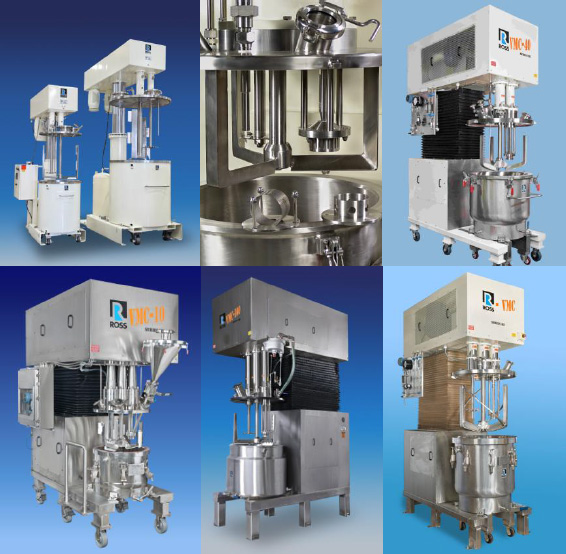Tech Report
Recommended Mixing Equipment for Cleaners and Degreasers

Application Summary
Mixing is a critical step in the production of degreasing and cleaning formulations because complete dissolution/dispersion of the surfactants, builders and additives directly impacts the end product`s efficacy and performance. It is a straight-forward operation that can be done in conventional stirred tanks but manufacturers realize that a versatile and efficient mixing system offers significant competitive advantages while reducing costs.
Multi-Shaft Mixers provide a unique combination of bulk agitation, rapid dissolution and superior heat transfer that makes them ideal for the economical processing of cleaners and degreasers for various applications.
Ross Multi-Shaft Mixers
Ross Multi-Shaft Mixers are widely used in the manufacture of degreasing and cleaning formulations. Equipped with two or more independently-driven agitators working in tandem, Multi-Shaft Mixers deliver a robust combination of high shear agitation and laminar bulk flow within a wide viscosity range: from water-like consistency to several hundred thousand centipoise.
The most economical design is the Dual-Shaft Mixer which features a low-speed anchor and a high-speed saw-tooth disperser blade. A common batching procedure begins with dissolving sodium salts and surfactants into water, mineral spirits, limonene or a blend of liquids. With the disperser blade fully submerged in the batch, it breaks down any particle agglomerates to accelerate the dissolution process. A versatile machine, the Dual-Shaft Mixer can also handle formulations that do not start off with any liquid components but instead require the melting of solid surfactants. Scrapers attached to the anchor agitator help promote uniform product temperature by enhancing heat transfer across the jacketed sidewalls and bottom of the mix can.
With individual speed control of each agitator, operators are able to fine-tune flow patterns and material turnover with each subsequent ingredient addition. Vacuum is typically applied throughout the entire mixing cycle to mitigate foam formation. Preservatives, dyes and fragrances, as well as liquid surfactants that tend to cause excessive foaming, may be added at the later stages of mixing.
Depending on the final viscosity, finished product is either discharged by gravity or pressed out of the vessel by a platen-style Discharge System. The latter method is recommended for thick or gel-like compounds.
Other Applications of Ross Multi-Shaft Mixers:
- Battery Slurries
- Beverages
- Creams and Lotions
- Dietary Supplements
- Filled Epoxies
- Flavorings
- Greases and Lubricants
- Gum Dispersions
- Hair Colors
- Hot-Melt Adhesives
- Inks and Coatings
- Liquid Make-Up
- Medical Gels
- Metal Slurries
- Ointments
- Rubber Solutions
- Sealants
- Solder Pastes
- Suspensions
- Syrups and Sauces
- Toothpaste
- Transdermal Patches
- Wax Emulsions

Advantages of Ross Multi-Shaft Mixers
- Versatility. Equipped with independently-controlled drives, the agitators in a Multi-Shaft Mixer can be engaged in any combination and at any speed for any interval during the mixing cycle. The combined mixing and heat transfer capabilities of each agitator results in a very robust system that can handle a wide range of viscosities.
- Protection against contamination. The Multi-Shaft Mixer is a closed system with no bearings or agitator seals submerged in the mixing area. Self-adjusting scrapers and flush discharge valves eliminate dead zones where product can stagnate.
- Cleanability. With change-can design Multi-Shaft Mixers, the agitators are raised and lowered by a hydraulic lift allowing easy access for cleaning between batches. CIP rotary spray nozzles may also be supplied.
- Scalability. Standard and sanitary models from 1 to 3000 gallons working capacity are available in both vacuum and atmospheric designs.
- Customers can rely on Ross for customizations and auxiliary equipment including custom sight/charge ports, interchangeable blades and mix vessels, load cells, temperature probes, heating units, vacuum pumps and controls ranging from simple Variable Frequency Drives and Operator Stations to more sophisticated PLC`s and HMI`s.